What is a Centrifugal Compressor?
A centrifugal compressor is a type of dynamic compressor that increases gas pressure by converting kinetic energy into potential energy. Unlike positive displacement compressors that trap and squeeze air in a confined space, centrifugal compressors use high-speed rotating impellers to accelerate gas outward, then convert this velocity energy into pressure through diffusion.
These machines excel in applications requiring large volumes of compressed air or gas at moderate pressure levels. The centrifugal compressor operates on principles of fluid dynamics, specifically Bernoulli’s principle, which states that an increase in fluid velocity corresponds to a decrease in pressure, and vice versa.
Basic Design and Classification
Centrifugal compressors fall under the broader category of turbomachinery and can be classified based on several factors:
- Number of stages: Single-stage (up to 2.5 bar), two-stage (2.5-5.5 bar), three-stage (6-13 bar), or multi-stage (up to 205 bar)
- Drive configuration: Direct-drive, geared, or high-speed
- Impeller design: Closed, semi-open, or open
- Casing type: Horizontally split or barrel design
- Application: Air compressors, process gas compressors, or refrigeration compressors
Working Principle of Centrifugal Compressors
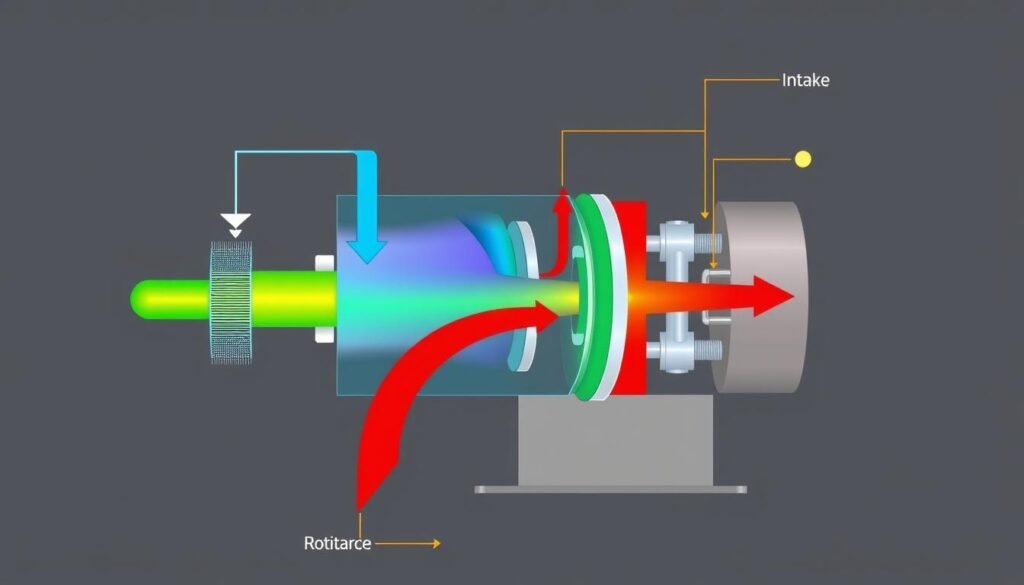
The centrifugal compressor works by converting mechanical energy into fluid energy through centrifugal force. This process follows several distinct steps:
- Intake: Gas enters the compressor through the inlet guide vanes and flows toward the center (eye) of the impeller.
- Acceleration: The high-speed rotating impeller imparts kinetic energy to the gas, accelerating it radially outward.
- Diffusion: The high-velocity gas exits the impeller and enters the diffuser, where the flow area gradually increases.
- Conversion: As the gas slows down in the diffuser, its kinetic energy converts to pressure energy according to Bernoulli’s principle.
- Collection: The compressed gas collects in the volute (scroll) casing and exits through the discharge port.
Thermodynamic Principles
The energy transfer in a centrifugal compressor can be described using Euler’s turbomachinery equation:
W = U₂C₂ – U₁C₁
Where:
W = Work input per unit mass
U = Impeller peripheral velocity
C = Absolute fluid velocity
Subscripts 1 and 2 refer to impeller inlet and outlet
The pressure ratio achievable in a single stage is limited by the impeller tip speed. For higher pressure ratios, multiple compression stages are used with intercooling between stages to approach isothermal compression, which is more energy-efficient than adiabatic compression.
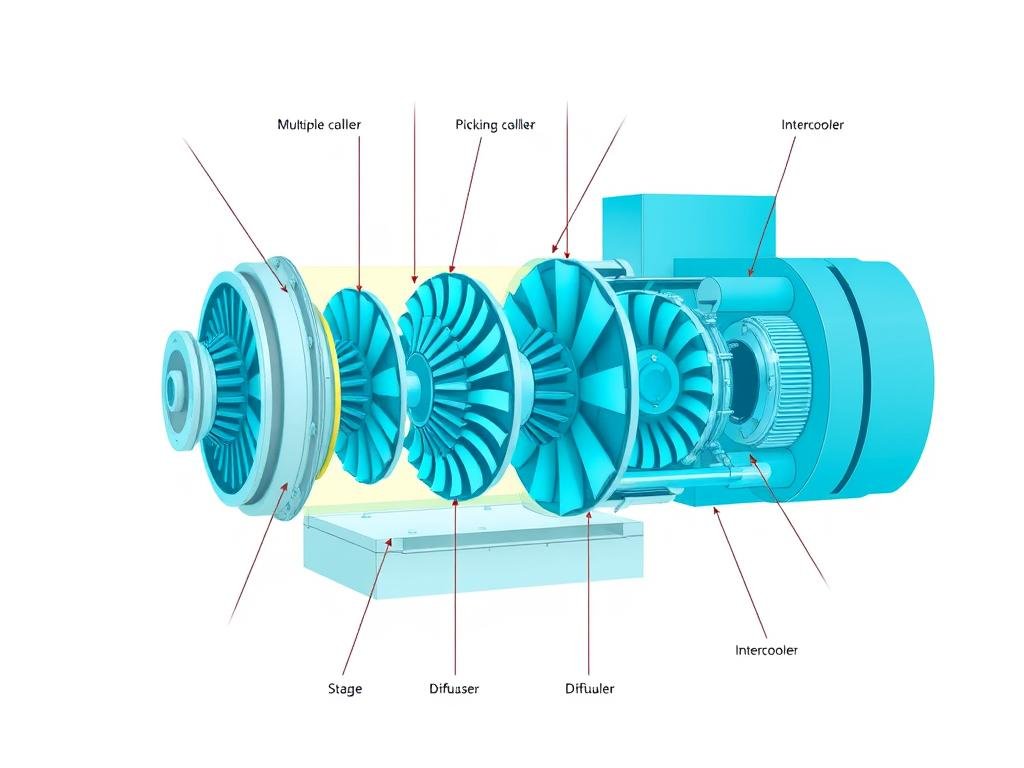
Multi-stage centrifugal compressor with intercooling between stages
Key Components of a Centrifugal Compressor
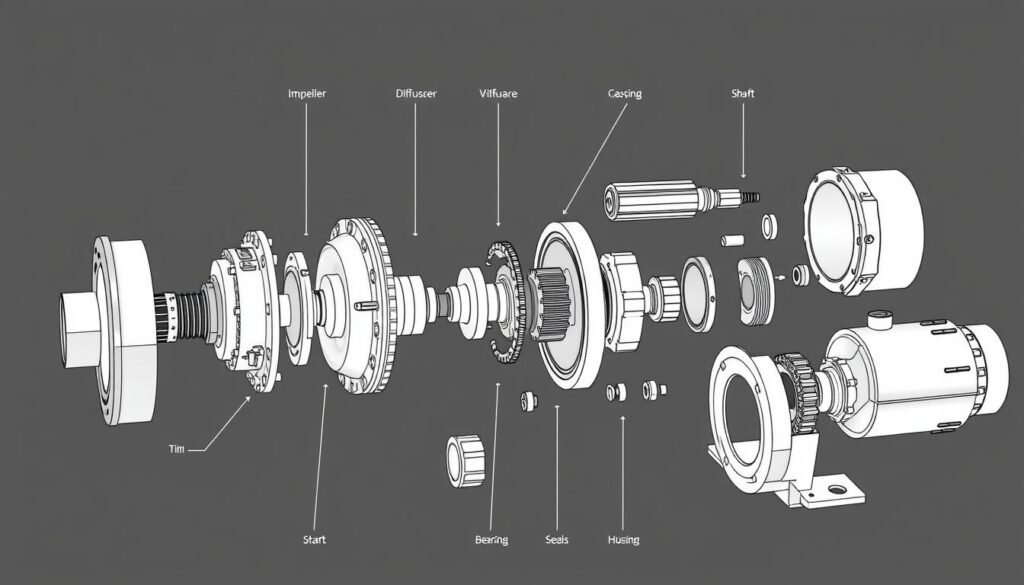
The performance and reliability of a centrifugal compressor depend on several critical components working in harmony:
Impeller
The impeller is the heart of the centrifugal compressor, responsible for imparting kinetic energy to the gas. Modern impellers feature complex three-dimensional blade designs optimized through computational fluid dynamics (CFD) to maximize efficiency.
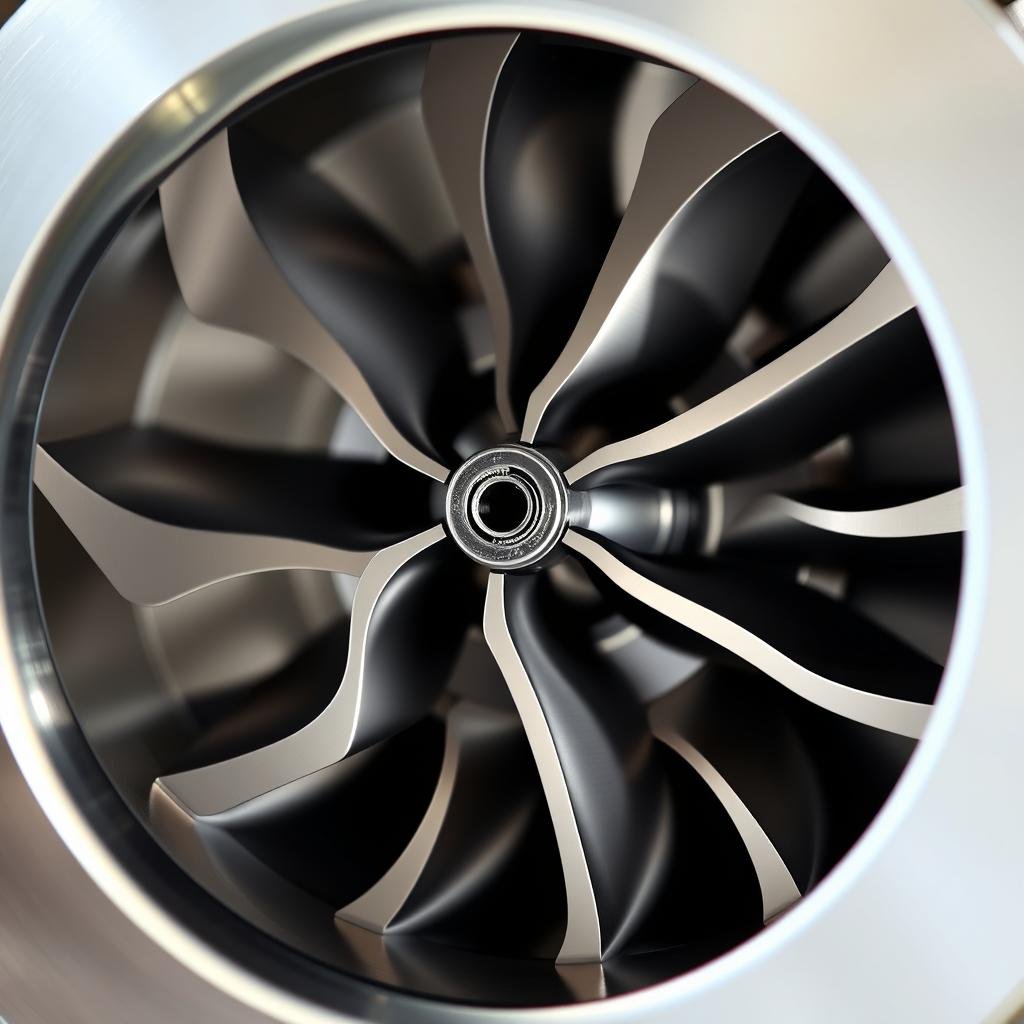
Modern centrifugal compressor impeller with backward-curved blades
Diffuser
The diffuser converts kinetic energy into pressure energy by gradually expanding the flow area, causing the gas to decelerate. Diffusers may be vaneless (a simple annular space) or vaned (containing fixed guide vanes) depending on the application requirements.
Volute Casing
The volute or scroll casing collects the compressed gas from the diffuser and directs it to the discharge port. Its spiral shape is designed to maintain constant velocity as the gas volume decreases, minimizing energy losses.
Additional Components
Shaft and Bearings
The shaft transmits power from the driver to the impeller. High-speed operation requires specialized bearings, typically hydrodynamic journal bearings for radial loads and thrust bearings for axial loads.
Seals
Shaft seals prevent gas leakage between rotating and stationary components. Labyrinth seals, dry gas seals, or mechanical seals may be used depending on the application.
Inlet Guide Vanes
Adjustable inlet guide vanes control the flow and pressure by pre-swirling the gas before it enters the impeller, providing an efficient method of capacity control.
Intercoolers
In multi-stage designs, intercoolers remove heat between compression stages, reducing power consumption and approaching isothermal compression.
Centrifugal vs. Reciprocating Compressors
Understanding the differences between centrifugal and reciprocating compressors helps in selecting the right technology for specific applications:
| Characteristic | Centrifugal Compressor | Reciprocating Compressor |
| Operating Principle | Dynamic (velocity-based) | Positive displacement |
| Flow Capacity | High (500-100,000 CFM) | Low to medium (50-5,000 CFM) |
| Pressure Range | Low to medium (up to 1,000 psi) | Medium to high (up to 60,000 psi) |
| Oil Contamination | Oil-free operation | Requires oil separation |
| Maintenance | Low (fewer moving parts) | High (many wearing components) |
| Efficiency at Part Load | Decreases significantly | Remains relatively high |
| Footprint | Compact for capacity | Larger for same capacity |
| Pulsation | Smooth, pulse-free flow | Pulsating flow |
Centrifugal Compressor Advantages
- 100% oil-free air for sensitive applications
- Continuous, pulse-free operation
- Lower maintenance costs and longer service intervals
- Higher reliability with fewer moving parts
- Smaller footprint for high-capacity applications
- Lower vibration and noise levels
Centrifugal Compressor Limitations
- Less efficient at partial loads
- Limited turndown capability
- Susceptible to surge at low flow rates
- Higher initial investment cost
- Less suitable for very high pressure applications
- More sensitive to changes in inlet conditions
Industrial Applications of Centrifugal Compressors
Centrifugal compressors excel in applications requiring large volumes of compressed air or gas at moderate pressures. Their oil-free operation makes them particularly valuable in industries where air purity is critical.
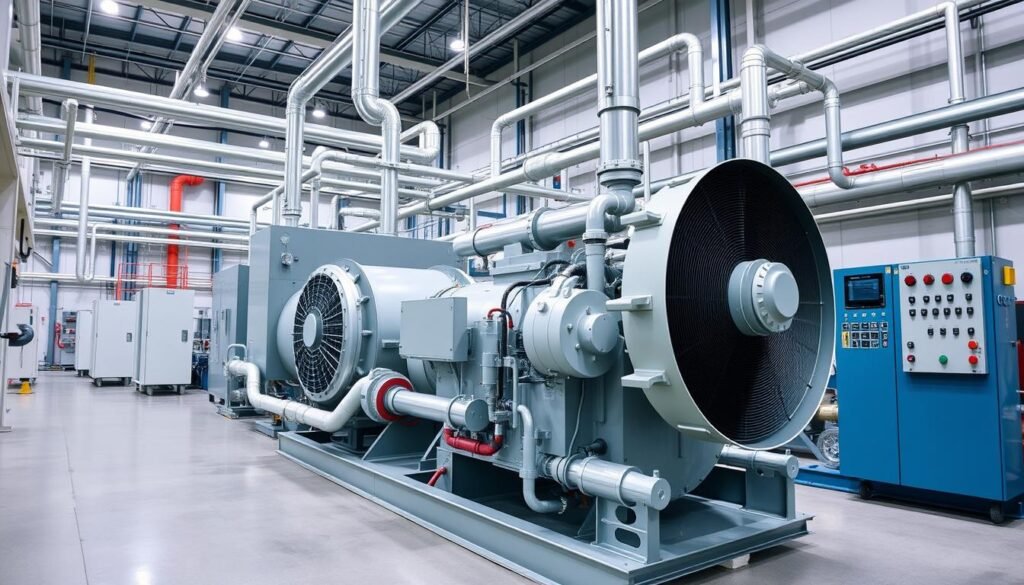
Large-scale centrifugal compressor installation in a manufacturing facility
Key Industry Applications
Oil & Gas
- Natural gas compression
- Gas lift operations
- LNG processing
- Refinery processes
Chemical & Petrochemical
- Process gas compression
- Synthesis gas production
- Refrigeration systems
- Air separation
Power Generation
- Combustion turbine inlet air
- Flue gas recirculation
- Carbon capture systems
- Cooling tower air supply
Food & Beverage
- Pneumatic conveying
- Packaging operations
- Fermentation aeration
- Refrigeration systems
Pharmaceutical
- Clean air systems
- Tablet production
- Fermentation processes
- Packaging operations
Wastewater Treatment
- Aeration systems
- Oxidation processes
- Backwash operations
- Ozone generation
Application-Specific Considerations
When selecting a centrifugal compressor for a specific application, several factors must be considered:
- Flow requirements: Centrifugal compressors are most efficient when operating near their design point.
- Pressure requirements: The number of stages needed depends on the required pressure ratio.
- Gas composition: Molecular weight and specific heat ratio affect compressor performance.
- Operating environment: Ambient conditions impact efficiency and capacity.
- Control requirements: Consider turndown needs and load variation patterns.
Real-World Centrifugal Compressor Examples
Atlas Copco ZH Series
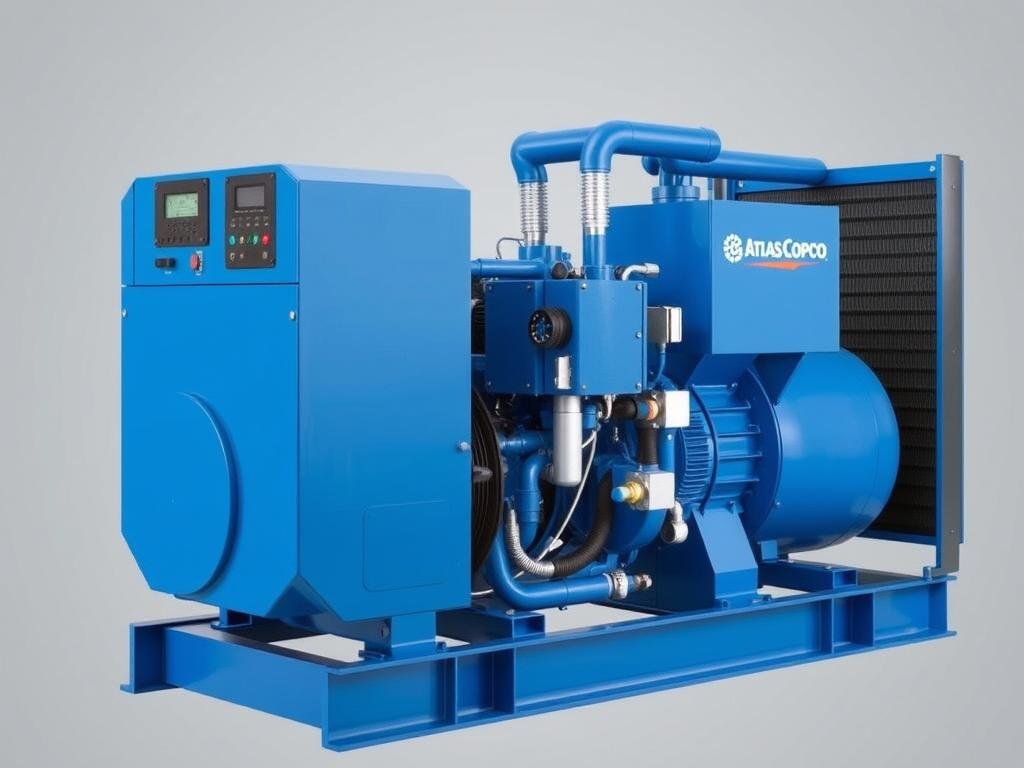
The Atlas Copco ZH Series represents state-of-the-art oil-free centrifugal compressor technology. These units deliver ISO 8573-1 Class 0 certified oil-free air for critical applications in the food, pharmaceutical, and electronics industries.
- Pressure range: 2-13 bar (30-190 psi)
- Flow capacity: 1,000-15,000 CFM (1,700-25,500 m³/h)
- Energy efficiency: Advanced impeller design with optimized flow paths
- Control system: Elektronikon® microprocessor with remote monitoring capabilities
- Key feature: Multi-stage design with efficient intercooling
Ingersoll Rand MSG® TURBO-AIR®
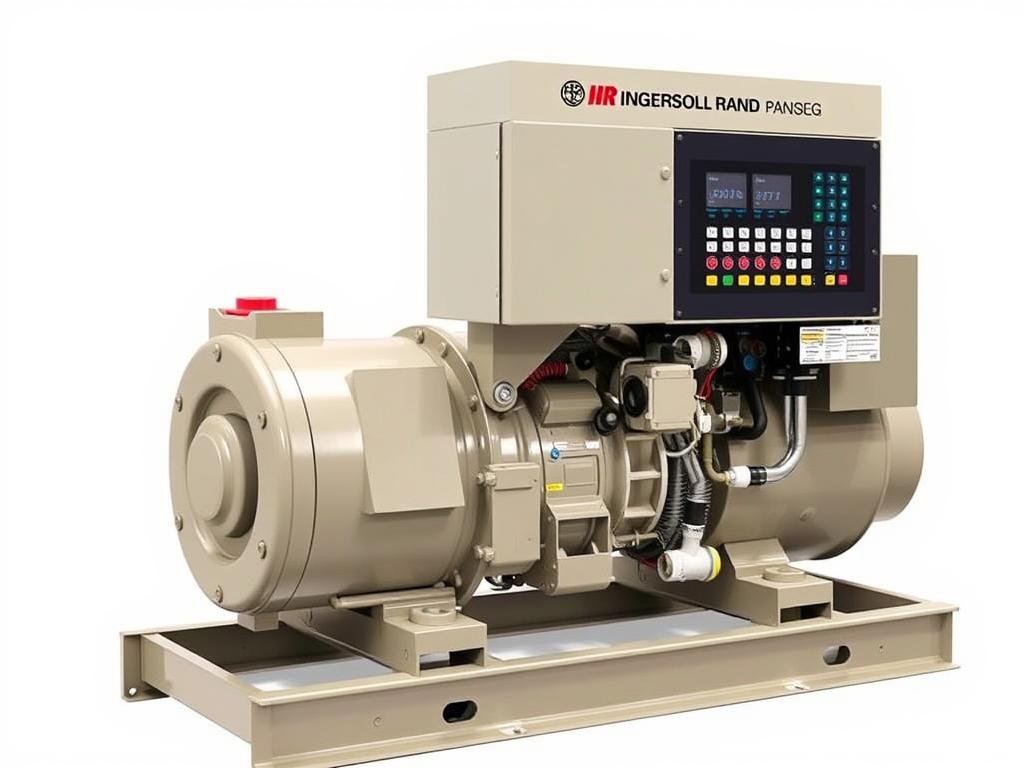
The Ingersoll Rand MSG® TURBO-AIR® series features integrally geared centrifugal compressors designed for industrial applications requiring reliable, efficient compressed air.
- Pressure range: 3-10.3 bar (40-150 psi)
- Flow capacity: 3,000-30,000 CFM (5,100-51,000 m³/h)
- Energy efficiency: Optimized impeller designs with advanced aerodynamics
- Control system: Xe-Series controller with predictive analytics
- Key feature: Horizontally split gearbox for easy maintenance access
Siemens STC-GV Series
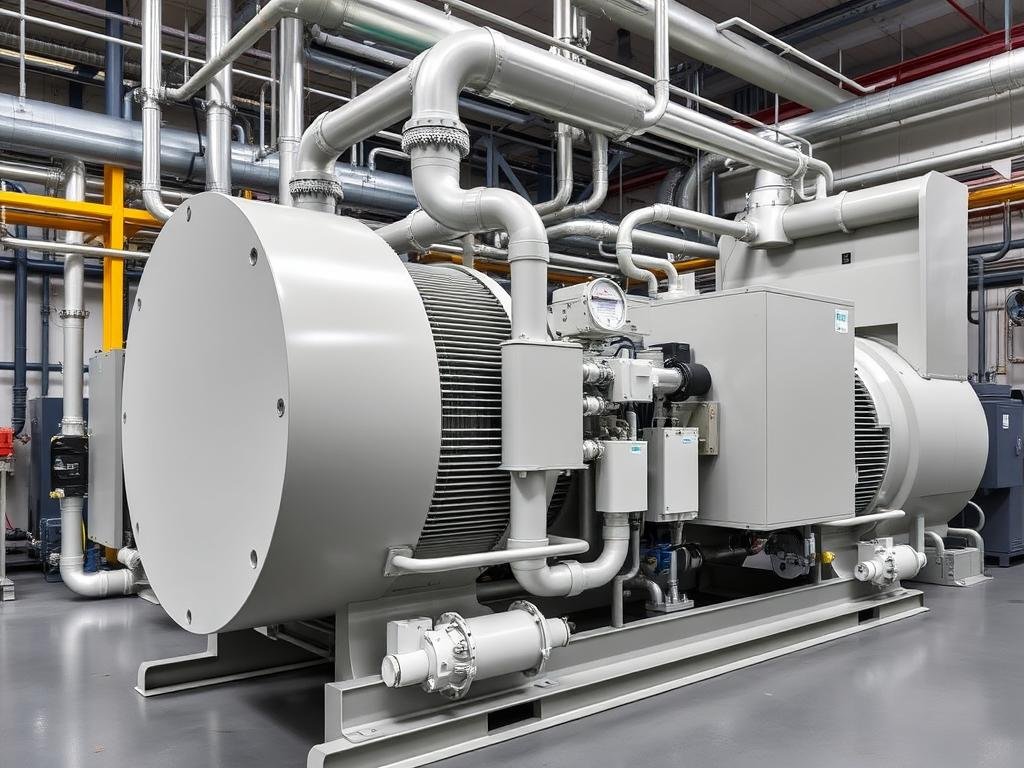
The Siemens STC-GV Series represents high-pressure process gas compressors used in demanding applications within the oil and gas, chemical, and petrochemical industries.
- Pressure range: Up to 200 bar (2,900 psi)
- Flow capacity: Up to 500,000 m³/h (294,000 CFM)
- Energy efficiency: 3D impeller design with optimized flow channels
- Control system: Integrated process control with anti-surge protection
- Key feature: Barrel-type casing for high-pressure applications
Frequently Asked Questions About Centrifugal Compressors
How does a centrifugal compressor work?
A centrifugal compressor works by converting mechanical energy into fluid energy. The high-speed rotating impeller accelerates gas radially outward, increasing its kinetic energy. As the gas flows through the diffuser, this kinetic energy converts to pressure energy as the gas velocity decreases. This process follows Bernoulli’s principle, which states that as fluid velocity decreases, its pressure increases. Multiple stages may be used with intercooling to achieve higher pressure ratios efficiently.
What maintenance do centrifugal compressors require?
Centrifugal compressors require less maintenance than reciprocating types due to fewer moving parts. Key maintenance activities include:
- Regular monitoring of vibration levels and bearing temperatures
- Periodic inspection and cleaning of inlet filters and coolers
- Lubrication system maintenance (oil analysis, filtration, cooling)
- Seal inspection and replacement as needed
- Impeller inspection for erosion or fouling
- Control system calibration and testing
Most manufacturers recommend a comprehensive inspection every 3-5 years of operation, depending on the application and operating conditions.
What is surge in a centrifugal compressor and how is it prevented?
Surge is an unstable operating condition that occurs when the flow through a centrifugal compressor becomes too low for the developed pressure, causing flow reversal and pressure fluctuations. This can damage the compressor and connected equipment. Surge is prevented through:
- Anti-surge control systems that monitor the compressor’s operating point
- Recycle or blow-off valves that maintain minimum flow
- Variable inlet guide vanes that adjust the flow characteristics
- Variable speed drives that match compressor output to demand
Modern control systems use sophisticated algorithms to predict and prevent surge conditions before they occur.
Why are centrifugal compressors considered oil-free?
Centrifugal compressors are considered oil-free because their compression chamber does not require oil for sealing or lubrication. The rotating impeller and stationary components maintain clearances without contact, eliminating the need for oil in the compression process. While bearings and gears require lubrication, sophisticated seal systems prevent oil migration into the compression chamber. This design delivers truly oil-free air, critical for applications in food processing, pharmaceuticals, electronics manufacturing, and other sensitive industries.
What is the efficiency of a centrifugal compressor?
Centrifugal compressors typically achieve isentropic efficiencies between 70-85%, depending on size, design, and operating conditions. Larger machines generally achieve higher efficiencies due to the “scale effect” – better flow characteristics and smaller relative clearances. Efficiency is highest when operating near the design point and decreases at partial loads. Modern designs with advanced aerodynamics, optimized diffusers, and variable speed drives have improved part-load efficiency. Multi-stage designs with intercooling approach isothermal compression, further enhancing overall system efficiency.
Conclusion: Is a Centrifugal Compressor Right for Your Application?
Centrifugal compressors represent an excellent choice for applications requiring large volumes of oil-free compressed air or gas at moderate pressures. Their reliability, efficiency, and low maintenance requirements make them particularly valuable in continuous process industries.
When evaluating whether a centrifugal compressor is right for your application, consider these key factors:
Consider a Centrifugal Compressor If You Need:
- Large flow volumes (>1,000 CFM)
- 100% oil-free air quality
- Continuous operation with high reliability
- Low maintenance requirements
- Smooth, pulse-free air delivery
Consider Alternative Technologies If You Need:
- Very high pressure ratios (>10:1 per stage)
- Excellent efficiency at widely varying loads
- Small flow volumes (
- Lower initial investment cost
- Simpler maintenance procedures
The optimal compressor selection requires careful analysis of your specific application requirements, including flow rates, pressure needs, air quality standards, and operating patterns. Working with experienced compression specialists ensures you select the technology that delivers the best total cost of ownership for your operation.
If tha very use in. This page